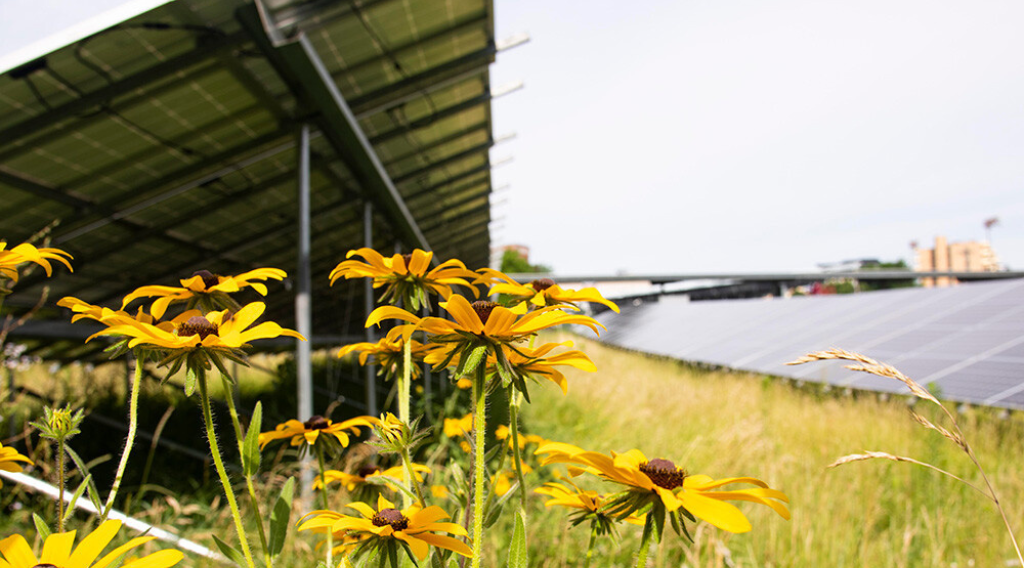
Last month, leaders from local governments, businesses, and other organizations came together at GPI’s third annual Energy Innovation Celebration to discuss energy and climate “Solutions from the Ground Up.”
We are inspired and energized by the conversations that were sparked at the event and look forward to working with existing and new partners on ideas that can make progress at the local and community level.
The event would not have been possible without the generous support of our Celebration sponsors, including 5ive, Cummins, Environmental Initiative, Fredrikson & Byron, Fresh Energy, Minnesota Power, Ottertail Power, Stoel Rives, Ulteig, University of Minnesota’s Institute on the Environment, and Wind on the Wires.
The event was opened by GPI’s Rolf Nordstrom and attendees were welcomed by Saint Paul Mayor Chris Coleman, who reflected that Saint Paul’s clean energy and climate action has gone hand in hand with making the city and community a smarter, cleaner, and more productive, resilient place for all its residents and businesses.
The afternoon included two discussions among city and business leaders, and was kicked off with a presentation by Brian Swett of Arup. In his presentation, Mr. Swett discussed:
- The potential for cities to make significant progress in the U.S. and globally toward reaching energy and climate goals.
- Analysis done by ARUP and C40 cities shows that U.S. cities with over 50,000 people could collectively achieve about 1/3 of the US commitment to the Paris Climate Accord and 6% of the cumulative emissions savings needed to reach global climate targets.
- National and international networks where communities and cities are making shared commitments and exchanging knowledge and resources.
I had the privilege of moderating the first panel discussion, titled “Energy & Climate Solutions: The Challenge and Opportunity for Cities.” It featured leaders from Arup, Cisco, the City of Minneapolis, and Siemens. The discussion focused on the vision of smart cities and the opportunities to improve people’s lives through action on energy and climate. Some of the key takeaways include:
- People must be at the center and foundation of any goals developed and any technology implemented to achieve successful, positive outcomes – and you must be outcomes focused.
- Opportunities abound within existing projects, systems, and budgets: cities have regular capital improvement plans and new infrastructure can and should be designed to be more resilient, efficient, and cleaner.
- Redesigned infrastructure projects can cost less, rather than more, especially over the project lifespan.
- Challenges of connecting across departments are being successfully overcome in many places. Although it may take longer to have more people involved, projects (e.g., streetlights), are being done “smarter” and providing additional value
- New finance models are expanding for how cities generate revenue and investors have a growing appetite for investing in smart infrastructure.
The next discussion, moderated by my GPI colleague Brian Ross, was titled, “Amplifying Solutions through Collaboration: Mayors and Business Leaders Dialogue.” The mayors of Des Moines, Iowa, and Eden Prairie, Minnesota, spoke along with leaders from 3M and Envision, Gundersen Health System. Some of the key takeaways include:
- Cities and businesses are both setting ambitious goals on energy, climate, and sustainability.
- Business and city actions to meet energy and climate goals are frequently independent of each other, yet there are many opportunities to work collaboratively and achieve more together.
- Cities and businesses can see each other as obstacles to achieving goals, rather than partners, unless they practice clear communication and engagement; cities need to know what businesses need to achieve their goals and vice versa.
- Businesses and cities have different tools to achieve their energy and climate goals, different frames of reference, and different boundaries within which they work. Finding synergies to take action requires deliberative effort.
After the panel discussions, Minnesota Senator Al Franken shared a video message underscoring the importance of local action on energy and climate, and highlighting how communities in Minnesota and the Midwest are already leading.
As part of the event, my colleagues asked the speakers: why are local energy and climate solutions important? Check out our slideshow to view some of the answers.
In addition to the main event, the Celebration started with two pre-event technical workshops the leading regional and national experts:
- Collaborations to Charge Ahead with Electric Vehicles. The workshop included panel discussion with representatives from local government, electric utilities, and businesses on the current state of electric vehicles (EVs) from their perspectives and what they are doing in the EV space. The discussion was followed by small group roundtable discussion about ideas to collaborate on EVs. You can view presentations from the discussion by:
– Brendan Jordan, Vice President, Great Plains Institute
– Annie Perkins, Sustainability Analyst, Andersen Windows
– David Ranallo, Marketing Communications Specialist, Great River Energy
– John Stine, Commissioner, Minnesota Pollution Control Agency
- How Carbon Disclosure Can Drive Climate Action. This workshop, led by the nonprofit CDP, discussed how cities can document carbon emissions and environmental performance disclosure. The workshop also covered how to collaborate better with the private sector, including how to increase private investments in your city’s projects. You can view the presentation by Amy Kao of CDP here.
Stay tuned to our blog for more follow-up from the workshops.
We look forward to continuing to work with all the speakers and attendees to accelerate collaboration on local clean energy and climate action.


